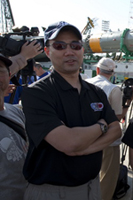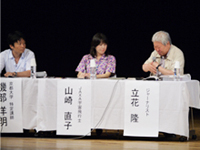JAXA Astronaut Activity Report, June 2011
Last Updated: August 18, 2011
This is JAXA's Japanese astronaut primary activity report for June 2011.
Astronauts Wakata and Noguchi support the Soyuz TMA-02M (27S) launch

The Soyuz TMA-02M (27S) launch (Credit: JAXA/NASA/Carla Cioffi)

Astronaut Noguchi answering questions from reporters at the Baikonur Cosmodrome (Credit: JAXA)
Astronauts Wakata and Noguchi visited and supported Astronaut Furukawa and the other 28 Expedition crew members in various ways during the Soyuz TMA-02M (27S) launch/docking and the start of their long-term stay on the ISS.
Astronaut Noguchi, who has experience aboard the Soyuz spacecraft, explained the details of the Soyuz TMA-02M (27S) launch and the docking to the press. During his post-launch interview, Astronaut Noguchi yelled to Astronaut Furukawa, “This is the reward for your 12 years’ training. At first, you will find each day seems very long, but you will soon find the time whizzing by quickly. So I recommend you perform each task carefully at first, and as you get used to the lifestyle, try whatever you have in mind”.
Two days after the launch, Astronaut Wakata witnessed Astronaut Furukawa and the other 27S crew members arriving and entering the International Space Station (ISS). During the press coverage, he commented “I’m glad to see Astronaut Furukawa and all the 27S crew members made it to the ISS. Astronaut Furukawa is a great Soyuz flight engineer. As one of the Japanese astronauts, I’m proud of him”.
In addition, a message from Astronaut Hoshide, one of Astronaut Furukawa’s colleagues, who is now training in Houston, U.S. for a long-term stay on the ISS, arrived one day before the launch. “As one of his colleagues, I’m very excited for the launch tomorrow. I imagine you will run through the stay without a break, but don’t forget to take time to see and feel beautiful Earth. I look forward to hearing about your stay”.
Training at ESA for the ISS long term stay
One of the 32/33 Expedition crew members, Astronaut Hoshide, trained at the European Astronaut Centre (EAC) of the European Space Agency (ESA), where he learned how to operate the Automated Transfer Vehicle (ATV) and “Columbus”, the European laboratory module. He also learned how to use and handle experimental equipment and hardware.
Specifically, he received training on rendezvous operations, including preparation for any contingencies. As a result Astronaut Hoshide became the first Japanese astronaut to have received rendezvous and docking training on the ATV.
Astronaut Candidate Training
Astronaut candidates Yui, Onishi, and Kanai are continuing their training at the NASA Johnson Space Center (JSC), U.S.
Astronaut candidate Yui was trained in Extravehicular Activity (EVA) at the Neutral Buoyancy Laboratory (NBL) as well as Refresher Training (to maintain and/or improve techniques and knowledge) for the Space Station Remote Manipulator System (SSRMS) operations. Astronaut candidate Onishi received a lecture on the amateur ham radio and obtained the license. All three candidates are continuing language training and flight training using the T-38 jet trainer.
The Committee on the Peaceful Uses of Outer Space (COPUOS) celebrates its 50th anniversary

Exhibition on human spaceflight programs (JAXA’s exhibition bottom right,
Credit: Permanent Mission of Japan to International Organizations in Vienna)
The Committee on the Peaceful Uses of Outer Space (COPUOS) met in early June at the Vienna International Centre, Vienna, Austria, celebrating its 50th anniversary and also the 50th anniversary of human spaceflight. Astronaut Mukai, as senior advisor to the JAXA executive director, and Astronaut Noguchi, as a representative of the Association of Space Explorers (ASE), participated in the committee.
COPUS is an organization which plays a key role in establishing space law and ensuring the peaceful uses of outer space. 79 global nations participated in this commemorative committee.
During the committee period, a special event “Astronauts and Cosmonauts Panel (a public event)” was held on June 2 at the City Hall of Vienna, which saw two hundred people, including public audiences, attend. Astronaut Noguchi, together with other astronauts around the world, participated in this event which was chaired by Dr. Takao Doi, former JAXA astronaut and now chief of the Office of Outer State Affairs, Space Applications Section of the United Nations. Astronaut Mukai, who participated as a panelist with other astronauts around the world, discussed how aspects of multicultural understanding such as differences and similarities would strengthen global cooperation as human space expeditions are conducted within a multicultural environment.
In addition, during the reception held on the same day, June 2, Astronauts Mukai and Noguchi each introduced their own long-term stays in space. They also introduced Dr. Yasushi Horikawa, a technical advisor to the JAXA executive director, who was elected as the committee chair for the next committee session. His accomplishments in term of space advancement were also introduced.
During the 10-day committee session, a video message from the ISS crew members in orbit and an introduction video of Astronaut Furukawa were played. In addition, panels presenting human space expedition and the ISS were exhibited.
The 28th International Symposium of Space Technology and Science (ISTS)
Astronauts Mukai and Yamazaki attended the 28th International Symposium of Space Technology and Science (ISTS), held
June 5-12, at the Okinawa Convention Center, in Ginowan City, Okinawa Prefecture.
ISTS intends to deepen exchange among domestic and international space specialists through workshops and discussion opportunities. In the field of space engineering, ISTS is the largest symposium in Japan. As well as holding workshops and discussions, ISTS also emphasizes conducting events such as exhibitions and educational activities.
Astronaut Yamazaki joined a panel discussion under the theme of “Human Exploration in Space” and joined other panelists in discussing the current significance of space development, 50 years after the first human space flight, the reasons for continuing to strive for further human space development, and the greatest benefits that human space development brings to us.

Astronaut Yamazaki participates in the panel discussion (Credit: JAXA)
During the panel discussion under the theme of "Humanity, Society and Culture in the Space Era”, the future of the ISS and how humans can be involved in space were discussed in space in terms of the humanities and social sciences.
Astronaut Yamazaki gave a lecture entitled “A message from space” and introduced her activities during the STS-131/ISS-19A mission.




